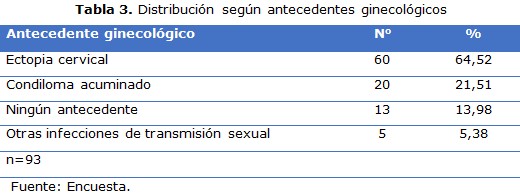Human papillomavirus in adolescents and people younger than 25
Abstract
Background: genital infection caused by human papillomavirus is a common sexually transmitted infection, which affects millions of people around the world.
Objective: to determine the behavior of human papillomavirus of genital location in adolescents and young women under 25 years.
Methods: a cross-sectional descriptive study was carried out in girls under 25 years of age attended in the neck pathology clinic of the Nuevitas Polyclinic in the period from January to December 2016; with a universe of 93 patients that with confirmed diagnosis of human papillomavirus in organic cytology.
Results: the greatest number of patients with human papillomavirus presented intraepithelial lesions, with a high degree of predominance. More than half of the injuries corresponded to the group of young people between 20 and 24 years old. Relationship of the presence of the virus with several risk factors was observed, almost all had their first sexual intercourse early. Around the third part of them had multiple sexual relations, three to five sexual partners prevailed, cervical ectopia was relevant, as gynecological history, leukorrhea was observed as the most frequent symptom.
Conclusions: there is a close relationship between adolescents with risks and presence of human papillomavirus, the presence of this virus is a predisposing factor for cervical intraepithelial lesions.
DeCS: ADOLESCENT; REPRODUCTIVE TRACT INFECTIONS/diagnosis; PAPILLOMA VIRUS INFECTIONS/diagnosis; PAPILLOMA VIRUS INFECTIONS/prevention&control; SEXUALLY TRANSMITTED DISEASES/prevention&control.
Downloads
References
1. Serrano Gómez SE. Virus del papiloma humano y cáncer de cuello uterino ¿Vacunar o no vacunar? MedUNAB [Internet]. 2015 [citado 05 Ene 2020];18(2):103-104. Disponible en: http://revistas.unab.edu.co/index.php?journal=medunab&page=article&op=view&path%5B%5D=2515&path%5B%5D=2148
2. Teixeira Lisiane O, Vieira Valdimara C, Germano Fabiana N, Gonçalves Carla V, Soares Marcelo A, Martinez Ana MB. Prevalence of Human Papillomavirus types in women attending at University hospital in southern Brazil. Medicina [Internet]. 2016 [citado 03 Feb 2020];49(2):116-123. Disponible en: http://revista.fmrp.usp.br/2016/vol49n2/AO4-Prevalencia-dos-tipos-de-Papilomavirus-Humano-em-mulheres.pdf
3. Melo Angermeyer A, Lagos N, Montenegro S, Orellana Juan J, Vásquez AM, Moreno S, et al. Virus papiloma humano y Chlamydia trachomatis según número de parejas sexuales y tiempo de actividad sexual en estudiantes universitarias en la Región de La Araucanía, Chile. Rev Chil Infectol [Internet]. 2016 [citado 03 Feb 2020];33(3):287-292. Disponible en: http://www.scielo.cl/scielo.php?script=sci_arttext&pid=S0716-10182016000300006&lng=es
4. Ceccato Junior BP, Guimarães Mark DC, Lopes Ceccato AP, Nascimento Lorena F, Novaes Magalhães L, Castillo Méndez D, et al. Incidence of Cervical Human Papillomavirus and Cervical Intraepithelial Neoplasia in Women with Positive and Negative HIV Status. Rev Bras Ginecol Obstet [Internet]. 2016 [citado 03 Feb 2020];38(5):231-238. Disponible en: http://www.scielo.br/scielo.php?script=sci_arttext&pid=S0100-72032016000500231&lng=en
5. Machado de Almeida AP, Machado AP, Ávilla Sobrinho L, Almeida Gatto F, Aparecida Tozetti I. Infection with multiple types of human papillomavirus in sexually active young women. Medicina [Internet]. 2015 [citado 03 Feb 2020];48(6):573-579. Disponible en: http://revista.fmrp.usp.br/2015/vol48n6/AO6-Infeccao-por-multiplos-tipos-de-HPV-em-mulheres-jovens.pdf
6. Lau Serrano D, Millán Vega MM, Fajardo Tornés Y, Sánchez Alarcón C. Lesiones preinvasivas del cuello uterino. Rev Cubana Obstet Ginecol [Internet]. 2012 [citado 03 Feb 2020];38(3):366-377. Disponible en: http://scielo.sld.cu/scielo.php?script=sci_arttext&pid=S0138-600X2012000300009&lng=es
7. Rodríguez Martínez L, Sarduy Nápoles MR, Baladrón Castrillo I, Solares Asteasuainzarra AM, Martínez Chang YM. Evolución de las lesiones escamosas intraepiteliales de bajo grado del cérvix (2012-2013). Rev Cubana Obstet Ginecol [Internet]. 2018 [citado 03 Feb 2020];43(4): 1-12. Disponible en: http://www.revginecobstetricia.sld.cu/index.php/gin/article/view/269
8. Ferrá Torres TM, Santana Álvarez J, Barreto Argilagos G. La infección por papiloma virus humano en la mujer: una revisión del tema. AMC [Internet]. 2011 [citado 03 Feb 2020];15(6):1073-1086. Disponible en: http://scielo.sld.cu/scielo.php?script=sci_arttext&pid=S1025-02552011000600015&lng=es
9. García S, Domínguez-Gil M, Gayete J, Blanco M, Eiros JM, Frutos M, et al. Detección del VPH en mujeres con y sin alteraciones citológicas del cérvix en Castilla y León: estudio poblacional. Ginecol Obstet Méx [Internet]. 2017 [citado 03 Feb 2020];85(4):217-223. Disponible en: http://www.scielo.org.mx/scielo.php?script=sci_arttext&pid=S0300-90412017000400002&lng=es
10. Natal Fedrizz E, Fantin Ribeiro Â, Gomes de Aguiar F, Tonon Caporal F, Sommacal Luiz F, Raupp Gomes L. Oncogenic High-risk Human Papillomavirus Detection and Evaluation of Risk Factors in the Cervical Intraepithelial Neoplasia. DST J Bras Doenças Sex Transm [Internet]. 2015 [citado 03 Feb 2020];27(3-4):79-85. Disponible en: http://www.dst.uff.br//revista27-3-4-2015/DSTv27n3-4IN79-85.pdf
11. Manoel AL, Traebert J, Rebello Correa L, Martinelli Zapelini C, Trevisol Daisson J, Schuelter Trevisol F. Preliminary stages of a cross-cultural Brazilian Portuguese adaptation of a measurement tool for assessing public understanding of human papillomavirus. Cad Saúde Pública [Internet]. 2016 [citado 03 Feb 2020];32(7):[aprox. 6 p.]. Disponible en: www.scielo.br/article_plus.php?pid=S0102-311X2016000704003&tlng=en&lng=en
12. Flores Medina S, García Romero CS, Soriano Becerril DM, Figueroa Damián R, Márquez Acosta G. Genotipificación del virus del papiloma humano en mujeres que asisten a un hospital gineco-obstétrico de tercer nivel de la Ciudad de México. Rev Chil Obstet Ginecol [Internet]. 2016 [citado 03 Feb 2020];81(5):381-387. Disponible en: http://www.scielo.cl/scielo.php?script=sci_arttext&pid=S0717-75262016000500006&lng=es
13. Mehta AM, Mooij M, Branković I, Ouburg S, Morré SA, Jordanova ES. Cervical Carcinogenesis and Immune Response Gene Polymorphisms: A Review. J Immunol Res [Internet]. 2017 [citado 03 Feb 2020];2017:[aprox. 12 p.]. Disponible en: https://www.ncbi.nlm.nih.gov/pmc/articles/PMC5322437/.
14. Alonso Triana L, Soto Ramírez E, Ugalde Pérez M, Velazco Fajardo Y, Díaz Díaz D, Hernández Álvarez RM. Diseño de intervención educativa para la prevención del cáncer cérvico uterino en estudiantes universitarios. Rev Med Electrón [Internet]. 2019 [citado 03 Feb 2020];41(4):914-927. Disponible en: http://scieloprueba.sld.cu/scielo.php?script=sci_arttext&pid=S1684-18242019000400914&lng=es
15. Bolaños Díaz R, Tejada Romina A, Beltrán J, Escobedo Palza S. Evaluación costo-efectividad de dos alternativas de vacunación para el virus del papiloma humano en la prevención del cáncer cervical uterino. Rev Peru Med Exp Salud Pública [Internet]. Sep 2016 [citado 03 Feb 2020];33(3):411-418. Disponible en: http://www.scielosp.org/scielo.php?script=sci_arttext&pid=S1726-46342016000300411&lng=en
16. Salvent-Tames A, Romero-Viamonte K. Correlación cito-colpo-histológica en lesiones premalignas del cuello uterino en el Hospital Básico Píllaro en Ecuador. Rev Cubana Obstet Ginecol [Internet]. 2017 [citado 03 Feb 2020];43(3):[aprox. 9 p.]. Disponible en: http://www.revginecobstetricia.sld.cu/index.php/gin/article/view/234
17. Montero Lora Y, Ramón Jiménez R, Valverde Ramón C, Escobedo Batista FE, Hodelin Pozo E. Principales factores de riesgo en la aparición del cáncer cervicouterino. MEDISAN [Internet]. 2018 [citado 03 Feb 2020];22(5):[aprox. 8 p.]. Disponible en: http://scielo.sld.cu/scielo.php?script=sci_arttext&pid=S1029-30192018000500010
18. Domínguez Bauta S, Trujillo Perdomo T, Aguilar Fabré K, Hernández Menéndez M. Infección por el virus del papiloma humano en adolescentes y adultas jóvenes. Rev Cubana Obstet Ginecol [Internet]. 2018 [citado 03 Feb 2020];44(1):1-13 Disponible en: http://www.revginecobstetricia.sld.cu/index.php/gin/article/view/317
19. Gómez Moya D, González Bellón M, González Pérez S, Quintana García O. Correlación de los resultados de los métodos diagnósticos de las patologías del cuello uterino en el Hospital Camilo Cienfuegos. Rev Cubana Obstet Ginecol [Internet]. 2019 [citado 03 Feb 2020];45(3):[aprox. 14 p.]. Disponible en: http://revginecobstetricia.sld.cu/index.php/gin/article/view/478
20. Dávila Gómez HL, Matos Rodríguez Z, Ravelo Nápoles S, Esquivel Díaz O, López Ruiz M. Lesiones epiteliales del cérvix en pacientes sin citología alterada en la Isla de la Juventud (2014-2015). Rev Cubana Obstet Ginecol [Internet]. 2018 [citado 03 Feb 2020];43(4):[aprox. 10 p.]. Disponible en: http://www.revginecobstetricia.sld.cu/index.php/gin/article/view/272
21. Villafuerte Reinante J, Hernández Guerra Y, Ayala Reina ZE, Naranjo Hernández L, González Alonso JÁ, Brito Méndez M. Aspectos bioquímicos y factores de riesgo asociados con el cáncer cervicouterino. Rev Finlay [Internet]. 2019 [citado 03 Feb 2020];9(2):138-146. Disponible en: http://scieloprueba.sld.cu/scielo.php?script=sci_arttext&pid=S2221-24342019000200138&lng=es

Published
How to Cite
Issue
Section
License
Copyright: Camagüey Medical Archive Magazine, offers immediately after being indexed in the SciELO Project; Open access to the full text of the articles under the principle of making available and free the research to promote the exchange of global knowledge and contribute to a greater extension, publication, evaluation and extensive use of the articles that can be used without purpose As long as reference is made to the primary source.
Conflicts of interest: authors must declare in a mandatory manner the presence or not of conflicts of interest in relation to the investigation presented.
(Download Statement of potential conflicts of interest)
The Revista Archivo Médico de Camagüey is under a License Creative Commons Attribution-Noncommercial-No Derivative Works 4.0 International (CC BY 4.0).
This license allows others to distribute, to mix, to adjust and to build from its work, even for commercial purposes, as long as it is recognized the authorship of the original creation. This is the most helpful license offered. Recommended for maximum dissemination and use of licensed materials. The full license can be found at: https://creativecommons.org/licenses/












 22 julio 2025
22 julio 2025